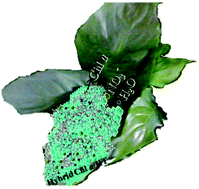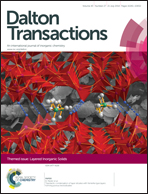Preparation of layered double hydroxide/chlorophyll a hybrid nano-antennae: a key step†
Abstract
In the first step to obtain an efficient nano-antenna in a bottom-up approach, new hybrid materials were synthesized using a set of layered double hydroxides (LDHs) with basic properties and pure chlorophyll a (Chl a). The stability of the adsorbed monolayer of Chl a was shown to be dependent on the nature and the ratio of the different metal ions present in the LDHs tested. The hybrid materials turned out to be adequate for stabilizing Chl a on Mg/Al LDHs for more than a month under ambient conditions while a limited catalytic decomposition was observed for the Ni/Al LDHs leading to the formation of pheophytin. These changes were followed by namely XRD, DR-UV-vis and fluorescence spectroscopies of the hybrid antennae and of the solutions obtained from their lixiviation with acetone or diethylether. On Mg/Al hydrotalcites the stability of the adsorbed Chl a was equivalent for values of the metal atom ratio ranging from 2 to 4. The latter hybrids should constitute a good basis to form efficient nanoscale light harvesting units following intercalation of selected dyes. This work describes an efficient preparation of Chl a that allows scale-up as well as the obtention of a stable Chl a monolayer on the surface of various LDHs.

- This article is part of the themed collection: Layered Inorganic Solids

 Please wait while we load your content...
Please wait while we load your content...